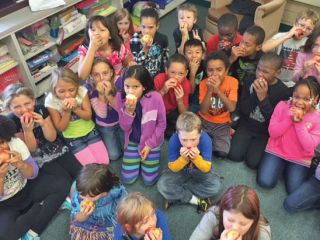Over the coming months, look for videos, stories and events that feature some of the many Wayne State initiatives and passionate individuals committed to impacting their communities through innovation and entrepreneurship. This content is part of WSU's Warriors in Action campaign highlighting how Wayne State is making a difference.
 Throughout most of his young life, a boy struggled with his weight. But with his classmates, teachers and parents cheering at the finish line, he completed what he thought he might never accomplish — a 5K run.
Throughout most of his young life, a boy struggled with his weight. But with his classmates, teachers and parents cheering at the finish line, he completed what he thought he might never accomplish — a 5K run.
Tim Podlewski, principal at Yake Elementary School in Woodhaven, Michigan, says the student’s success was due, in large part, to the Building Healthy Communities program operated by Wayne State University’s Center for Health and Community Impact.
“This student had struggled with his weight throughout his time here,” Podlewski says. “He participated in the program’s Healthy Kids Club as well as a local YMCA program. He didn’t run the entire 5K — he walked some of it — but he finished to the cheers of his friends, teachers and family. It was a wonderful achievement.”
Healthy Kids Clubs are one of six components of a healthy school initiative called Building Healthy Communities. The program is a partnership between Blue Cross Blue Shield of Michigan, the Center for Health and Community Impact at WSU, the Michigan Department of Health and Human Services, the United Dairy Industry of Michigan, and the Michigan Fitness Foundation to improve the current and future health of elementary school students.
Nate McCaughtry, professor and assistant dean for the Division of Kinesiology, Health and Sport Studies and director of the university’s Center for Health and Community Impact, spearheads the effort, which was founded in 2009.
Providing students, faculty members and parents with opportunities and education around physical activity and healthy eating are at the core of the Building Healthy Communities program. During the 2015-16 school year, the program was put into action at 40 schools across Michigan.
Since 2009, Building Healthy Communities has been implemented in over 300 schools, reaching more than 100,000 students and their families as well as 3,000 teachers and administrators. Students throughout Michigan have seen improved health, developing skills they will be able to use throughout their lifetimes.
An array of educational materials, curricula, healthy living education and lifetime-guaranteed sports and playground equipment is provided to every school. WSU coordinators operate the program in each school by kick-starting all six healthy school components and then transitioning into a “train-the-trainer” model to create a sustainable school-based program, with each school using their unique insights.
“Succeeding academically at a university requires writing research papers, books and getting published,” McCaughtry says. “We gather data and analyze it to measure the effects of the program.
“What really gets to me is seeing the real, tangible benefits to the community. You see healthier children, healthier faculty and healthier parents as a result of the work we do. I’ve attended many events at the schools to celebrate the program, and when you see the equipment we’ve provided in use and see the excitement of the kids who are being taught what’s right when it comes to healthy living — it’s truly rewarding,” he adds.
Podlewski says his students participated in the weekly after-school Healthy Kids Club. Faculty members and students set a goal of running the distance to Disneyland in California by tallying the miles they ran during the school year. He donned his running shoes and participated as well.
“We had about 100 kids each week,” Podlewski says. “That’s roughly 25 percent of a school’s population. Our teachers participated as well. When they reached the goal, we had a big celebration.”
Tom Crane, Ed. ’14, a Yake Elementary physical education instructor, was instrumental in applying for the program and then taking the reins when it was approved. “Tom has worked with the kids, created enthusiasm, collected the data,” Podlewski says. “It was exciting to watch the growth in the faculty and the students.”
McCaughtry said his team collects data and measures things like the increase in physical activity, healthy eating behaviors, knowledge and attitudes among students and school personnel. While these achievements have led to significant decreases in students’ obesity over the course of the school year, other lessons have the chance of improving their health for a lifetime.
The program has the ability to help schools start a garden. Half of participating schools reported using their gardens for school-wide vegetable tastings while also collaborating with their food service providers.
“Our food service vendor has worked with us closely in providing foods for our cafeteria that have a healthy emphasis,” Podlewski says. “For instance, we have no fryers anywhere in the building. We have had arugula tastings and other fresh vegetables our students could try — many for the first time.”
While the program has its own core lesson plans and activities, it tends to take on a life of its own at each school. Podlewski says the school music teacher developed health-related songs and exercise chants, and art teachers encouraged students to create health-related posters and fliers. Each gives the program a multifaceted approach that complements its emphasis on physical activity and nutrition.
There are numerous other benefits to Building Healthy Communities that are more difficult to measure, but parents and teachers easily recognize them.
“Students who eat well and engage in physical activity tend to sleep more soundly,” McCaughtry says. “They also tend to pay better attention in class and do better in both reading and math. They also tend to have fewer emotional issues. They are less worried, less angry, less forgetful and less afraid.”
This story was originally published in the fall 2016 edition of Wayne State Magazine.